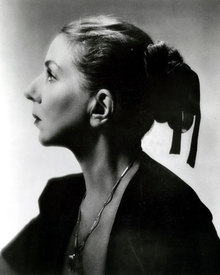Hanya Holm
Hanya Holm | |
|---|---|
 | |
| Born | Johanna Eckert 3 March 1893 Worms, Rhineland-Palatinate, German Empire |
| Died | 3 November 1992 (aged 99) New York City, New York, U.S. |
| Education | Dalcroze Institute of Applied Rhythm, Wigman School |
| Occupation(s) | Dancer, choreographer, educator |
| Known for | Modern dance |
Hanya Holm (born Johanna Eckert; 3 March 1893 – 3 November 1992) is known as one of the "Big Four" founders of American modern dance. She was a dancer, choreographer, and above all, a dance educator.[1]
Early life, connection with Mary Wigman
Born as Johanna Eckert on 3 March 1893 in
At the age of 28, she saw the German expressionist Mary Wigman perform, and decided to continue her dance career at the Wigman School in Dresden where she soon became a member of the company. Mary Wigman and Hanya Holm shared a special bond through movement. Egyptian Dance was said to be the first time Wigman realized the artistic impression Holm was capable of. She had the creative will and ability to shape a choreographic vision into reality.[3]
Wigman invited Holm to teach, co-direct the Dresden School, and in her recognition of the opportunity that opening a school in New York could offer the world of dance, eventually sent Holm to launch a Wigman branch in New York City (on September 26, 1931). The initial letters of certification and agreement from Wigman to Holm about the migration over to America to direct the school were found in her house after her death in 1992. These letters were published in Dance, Business, and Politics: Letters from Mary Wigman to Hanya Holm.[4] In the letters the salary was laid out making sure that the transfer would continue to support her son, Klaus, who stayed in Germany, and the letter of agreement signed by both parties "promises to apply all her strength to the advancement of the New York Wigman School and to conduct the work according to Mary Wigman's ideas ... as well as to see that the M.W. philosophy of dance is implemented faithfully within and outside the New York Wigman School in every possible way".[4]
Hanya Holm Studio and Hanya Holm Dance Company
Holm was not only capable of rising to the challenge of representing the Wigman name and teaching philosophy, she also helped to shape the school and build an influence of her own. Due to the rise of Nazism and a need to distance the school from German ties, it became known as the Hanya Holm Studio (1936–1967).[5]
Additionally she formed the Hanya Holm Dance Company in 1936, former dancers of the company included Keith Coppage, Carolyn Durand, Marva Jaffay, Mimi Kagan, Louise Kloepper, Henrietta Greenhood (later known as Eve Gentry), Ruth Ledoux, Lydia Tarnower, Bernice Van Gelder, Elizabeth Waters, Oliver Kosock, Gretchen Phillips, and Lucretia Wilson.[6][7]
Holm's first United States performance was Trend (1937).[7]
Technique and choreography
Holm had a unique form of technique that shaped generations of dancers and choreographers including
Invited by dance director
In 1948, she choreographed for Broadway: Ballet Ballads and Kiss Me, Kate which led to twelve other musicals. Holm's dance work Metropolitan Daily was the first modern dance composition to be televised on NBC, and her
As a dance educator
Hanya Holm's approach to teaching was to liberate each individual to define a technical style of his or her own that should express their inner personality and give freedom to explore. She would tell her students, "You have a perfect right to branch out, if you have the stuff in you, if you discover your own richness, if you have something to say."
She taught at Colorado College, Mills College, University of Wisconsin, Alwin Nikolais School,
Family and death
Her son was Broadway lighting designer Klaus Holm. She and her son are interred in Hanover Township, Luzerne County, Pennsylvania. She was divorced from Reinhold Martin Kuntze, a German sculptor.[2]
Holm has been honored by the
Holm died at the age of 99 of pneumonia on 3 November 1992 in New York City, New York.[2]
See also
References
- ^ a b Craine & Mackrell 2000, p. 235.
- ^ ISSN 0362-4331. Retrieved 2022-03-06.
- ^ Sorell 1969, p. 17.
- ^ a b Gitelman & Forster 1997.
- ^ Foulkes 2002, p. 121.
- ISBN 978-1-4766-0295-0.
- ^ a b c d "Hanya Holm Dance Concert Set at CC". Newspapers.com. Colorado Springs Gazette-Telegraph. August 4, 1973. p. 77. Retrieved 2022-03-07.
- ^ Cristofori 1998, p. 358.
- ^ Sorell 1969, pp. 162–163, 165.
- ^ Reynolds & McCormick 2003, pp. 167–168.
- ^ Sorell 1969, p. 103.
- ^ Reynolds & McCormick 2003, p. 170.
- ^ Sorell 1969, pp. 102–103.
- ^ Sorell 1969, pp. 167–169.
- ^ Sorell 1969, p. 172.
- ^ Sorell 1969, p. 171.
Citations
- Craine, Debra; Mackrell, Judith, eds. (2000). "Hanya Holm". The Oxford Dictionary of Dance. New York: Oxford University Press. ISBN 978-0-19-860106-7.
- Cristofori, Marilyn (1998). "Hanya Holm". In Benbow-Pfalzgraf, Taryn (ed.). International Dictionary of Modern Dance. Detroit: St. James Press. ISBN 978-1-55862-359-0.
- Foulkes, Julia (2002). Modern Bodies: Dance and American Modernism from Martha Graham to Alvin Ailey. University of North Carolina Press. ISBN 978-0-8078-5367-2.
- Gitelman, Claudia; Forster, Marianne (1997). "Dance, Business, and Politics: Letters from Mary Wigman to Hanya Holm, 1930–1971". Dance Chronicle. 20 (1): 1–21. JSTOR 1567958.
- Reynolds, Nancy; McCormick, Malcolm, eds. (2003). "Hanya Holm". No Fixed Points: Dance in the Twentieth Century. Haven, CT: Yale University Press. ISBN 978-0-300-09366-7.
- Sorell, Walter (1969). Hanya Holm; the Biography of an Artist. Middletown, CT: Wesleyan University Press. ISBN 978-0-8195-6060-5.
External links
- Hanya Holm at IMDb
- Hanya Holm at the Internet Broadway Database
- Don Redlich papers, 1893-2019 Jerome Robbins Dance Division, New York Public Library for the Performing Arts
